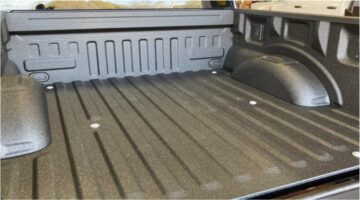The 2016 Lexus NX 300h hybrid compact luxury utility vehicle, in its sophomore year, continues to impress drivers with its surprising attention to detail, dramatic design and smooth hybrid drive. Inspired by performance vehicles, the NX unites the engineering input of racers with the impeccable touch of Lexus luxury in a design that steals the show with the signature Lexus spindle grille and L-finesse design.
The NX 300h carries over into 2016 model year with few changes. New exterior colors include Autumn Shimmer and Blue Vortex Metallic. Drivers can also now opt in for additional peace of mind and connectivity with Lexus Enform products.
Lexus Enform Service Connect (subscription required) allows customers to remotely view information about certain aspects of their Lexus vehicle via the MyLexusandBeyond mobile application for iOS smartphone users or LexusDrivers.com. Information includes maintenance alerts, warning light notifications and a vehicle health report. Lexus Enform Remote is also available for all NX vehicles.
When the NX 300h was introduced for 2015 model year, it brought the brand’s number of hybrid offerings to six, the most among luxury brands. The NX 300h hybrid features a 2.5-liter Atkinson-cycle gasoline engine with an automatic transmission.
The hybrid offers a real driving kick, thanks to a transmission with a kick-down function which helps ensure maximum power is delivered when required. The racers on the team insisted on splitting the hybrid battery into two separate pods for better weight distribution; with the benefit of more efficient use of cabin space.
The NX 300h hybrid, is offered in front-wheel drive (FWD) and all-weather drive (AWD). The hybrid features the Lexus E-Four proactive AWD system with an electric motor to drive the rear axle, while the front axle is propelled by gasoline or electric power, or a mixture of both. The sophisticated E-Four system varies torque distribution to the rear wheels, depending on driving dynamics and road conditions, and provides some rear-wheel torque at start-off to help minimize wheel-spin under acceleration and on slippery road surfaces.
E-Four saves energy and fuel, because the vehicle only uses all-wheel drive when needed. When the system detects loss of traction of the front wheels it reduces the electricity supply to the traction motor in the transaxle and increases supply to the rear-axle motor. The rear motor acts as a generator when the NX is in regenerative braking mode, increasing the amount of kinetic energy recovered.
The Lexus E-Four AWD system has situation-specific control features similar to Dynamic Torque Control proactive AWD in the NX 200t AWD model, including a yaw-rate control system for enhanced driving performance.
A pre-loaded front differential (and yaw rate feedback control on AWD versions) helps ensure optimized grip, control and agility. The differential uses a plate spring between the side gear and side-gear washer to add pre-load, which limits torque split between the front wheels. Under light loads, and when there is a low speed difference between the left and right wheels during cornering, the pre-loaded differential helps ensure straight-line stability and acceleration performance. At higher speeds, it operates as an open differential.
NX 300h: Hybrid With a Kickdown
The NX 300h shares the sporty persona of its turbocharged sibling while offering higher fuel efficiency. Lexus tuned the 2AR-FXE 2.5-liter gasoline engine especially for use in the NX 300h. Enhancements specific to NX hybrid include a water-to-oil cooler for the electric drive motor and a revised front drive reduction ratio, enhancing fuel economy and hill climbing.
Put your foot down on the highway, and you’ll feel the hybrid’s performance-tuned attitude. Its P314 transmission provides a kick-down function for greater acceleration performance. The transmission consists of an electric motor generator and an electric drive motor linked by a double set of planetary gears. The planetary gearset simultaneously fulfills three roles: as a power split device between the generator and the front wheels; as a reduction gear for the electric motor and, when both work together, as an electronically controlled continuously variable transmission (CVT).
The transmission offers sequential shift which allows maximum power to be delivered on demand and increases engine braking when decelerating.
The NX 300h employs Lexus’ electronically controlled braking system known as ECB-R to help provide cooperative control of stopping power and regenerative braking while saving on vehicle weight.
NX 300h: Driving Dynamics
Lexus did even more to give the NX 300h a more performance-tuned feel. The HV control software minimizes engine flare during acceleration and increases the sensation of linear acceleration. Engine speed is increased relative to the accelerator pedal angle. The NX 300h adjusts to the target engine speed and to the G force applied to the vehicle, providing a more natural acceleration feeling, without excessive adjustment to the engine speed and gear ratio. And, you can shift yourself with the sequential Shiftmatic feature.
Drivers can optimize fuel economy using Eco or Normal modes in Drive Mode Select, or use Shiftmatic in Sport mode to better enjoy a winding road.
The NX Hybrid has sprung weight damping control to help reduce pitching on uneven road surfaces and increase ride comfort and control. The system controls motor torque and adds power to the opposite direction to help minimize body movement. The rear motor (MGR) helps the starting off performance and stability on slippery roads.
The engineering team’s racing experience comes through in the way the Lexus NX handles curves and bumps. Engineers benchmarked the current generation Lexus IS to optimize driving dynamics in the NX. The foundation for the vehicle’s sublime blend of handling agility and ride comfort is a highly rigid body structure that makes extensive use of hot-stamped high tensile steel along with aluminum.
Construction techniques pioneered in the Lexus IS, particularly body adhesive, laser screw welding and additional spot welds, have been used to strengthen panel joints. A high rigidity urethane sealant introduced in the IS model is used for the NX windshield, effectively making the glass a load-bearing member and increasing resistance to body flex. Aluminum is used on the hood for weight savings.
NX 300h: Hybrid With a Kickdown
The NX 300h shares the sporty persona of its turbocharged sibling while offering higher fuel efficiency. Lexus tuned the 2AR-FXE 2.5-liter gasoline engine especially for use in the NX 300h. Enhancements specific to NX hybrid include a water-to-oil cooler for the electric drive motor and a revised front drive reduction ratio, enhancing fuel economy and hill climbing.
Put your foot down on the highway, and you’ll feel the hybrid’s performance-tuned attitude. Its P314 transmission provides a kick-down function for greater acceleration performance. The transmission consists of an electric motor generator and an electric drive motor linked by a double set of planetary gears. The planetary gearset simultaneously fulfills three roles: as a power split device between the generator and the front wheels; as a reduction gear for the electric motor and, when both work together, as an electronically controlled continuously variable transmission (CVT).
The transmission offers sequential shift which allows maximum power to be delivered on demand and increases engine braking when decelerating.
The NX 300h employs Lexus’ electronically controlled braking system known as ECB-R to help provide cooperative control of stopping power and regenerative braking while saving on vehicle weight.








